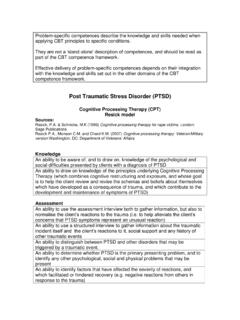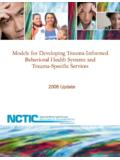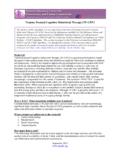Transcription of Kris Buffington TF-CBT Part 1 - ja.cuyahogacounty.us
1 kris Buffington , MSW, ObjectivesParticipants in this workshop will be able to:Idif hild i i i yIdentify ways child traumatic experiences can impact child development and a person s entire life spanyArticulate the rationale for use of evidence based Articulate the rationale for use of evidencebased trauma focused treatmentyUnderstand the core components of TF CBT and be bl df l f h able to identify examples of therapeutic interventions that relate to each componentyIncrease their skills in trauma focused assessmentCohen, Mannarino, & Deblinger, 2008 Increase their skills in traumafocused assessmentWhy are we here today?Cohen, Mannarino, & Deblinger, 2008 Cohen, Mannarino, & Deblinger, 2008 Sometimes things occur in children s livesthatcaninterferewithchildren slives that can interfere with children s abilities to reach their beautiful such as child abuse, neglect, violence, loss, wars, oppression, racism, ,,,pp,,sexism, poverty, and other , Mannarino, & Deblinger, 2008 TherearethingswecandotoThere are things we can do to , Mannarino, & Deblinger, 2008 Why Address Trauma ?
2 Cohen, Mannarino, & Deblinger, 2008 HigherUtilizersofMentalHealthStudy(Orego nHigher Utilizers of Mental Health Study(Oregon Dept. of Mental Health, 1999)During a 3 year time period in the mid 1990 s a group of 69 adults used million dollars in mental health services; Over 90% of these adults had experienced services; Over 90% of these adults had experienced childhood sexual and/or physical , Mannarino, & Deblinger, 2008 Risk of Juvenile Delinquencyy Girls who have been abused or neglected are twice as likely to be arrested as juveniles (Widom, 2000) % f h ild i h jil ji y 60% of youth involved in the juvenile justice system suffer from diagnosable mental disorders (Wood 2002, National Mental Health Association, 1999)Cohen, Mannarino, & Deblinger, 2008 Adverse Childhood Experiences SdStudy (Kaiser Permanente and CDC)yAdults who experienced at least 4 traumatic events in their childhood have increased risk of morbid obesity, are 2 times more likely to smoke cigarettes and are are 2 times more likely to smoke cigarettes, and are over 9 times more likely to have injected street drugs.)
3 (Felitti and Anda, 2003)Cohen, Mannarino, & Deblinger, 2008 Prevalence of Trauma in the Lives of ChildChildreny9 million adolescents have witnessed serious violence during their lifetimes (Kil t i k & Sd Nti l Ititt f Jti during their lifetimes (Kilpatrick & Saunders, National Institute of Justice, 1997)yOver one million children are assaulted, robbed, or raped h each year ( Depart. Of Justice, 1999)yApproximately 879,000 children where neglected or abused in 2000 (Children s Bureau, 2002)abused in 2000 (Children s Bureau, 2002)yEvery year 3 to 10 million children in the are exposed to domestic violence between their parents (Carter, , 1999; St )Straus, 1992).Cohen, Mannarino, & Deblinger, 2008 Trauma and Costs to SocietyCohen, Mannarino, & Deblinger, 2008 HigherUtilizersofMentalHealthStudy(Orego nHigher Utilizers of Mental Health Study(Oregon Dept. of Mental Health, 1999)During a 3 year time period in the mid 1990 s a group of 6 dl d illi dll i l hlh 69 adults used million dollars in mental health services; Over 90% of these adults had experienced childhood sexual and/or physical sexual and/or physical , Mannarino, & Deblinger, 2008 Mental Health and School Failure Children ith se ere emotional disturbances ha e Children with severe emotional disturbances have the highest rates of school failure.)
4 50% of these children drop out of school as compared to a 30% pp3of children with all other kinds of disabilities. (President s New Freedom Commission, 2003)Cohen, Mannarino, & Deblinger, 2008 ResiliencyyDr. Ann Masten The great danger I see in the idea of resilience is in expecting children to overcome deprivation and danger on their own There is no magic here danger on their is no magic , Mannarino, & Deblinger, 2008 Resiliency (cont d)yDr. Ann Masten .. R e s i l i e n t children have been protected by the pyactions of adults, by good nurturing, by their assets, and by opportunities to Cohen, Mannarino, & Deblinger, 2008 What happens to children under hid?chronic trauma and stress?yThe emergency centers of the brain can be overused, overdeveloped, at the expense of the h f h bi h l i other parts of the brain that control reasoning, learning, emotional and behavioral regulation, and the ability to manage social relationshipsthe ability to manage social (1997) analogy of a network of dense streets(National Clearing House on Abuse & Neglect Early Child (National Clearing House on Abuse & Neglect, Early Child )Cohen, Mannarino, & Deblinger, 2008 Trauma and MemoryyExplicit Memory: is the non emergency memory; i dd it th bi i d d memories are encoded into the brain in words, and filed logically; we use this type of memory when we are learning in school and work Memorystores our habits.)
5 Memories are encoded in physical sensations, in fragments, and are stored with emotional , Mannarino, & Deblinger, 2008 AttentionDeficitHyperactiveDisorderinclu desAttention Deficit Hyperactive Disorder includes the disabilities in the following areas:yAbility to be Ref lective: the ability to think yAbility to be Ref lective: the ability to think before actingySelectivity: the ability to focus and screen out Selectivity: the ability to focus and screen out the important from the unimportantyAbility to Resist DistractionyContinuity of Attention: impacts ability to sustain attention and complete assignmentsSlfA d SlfRliThi ySelf Awareness and Self Regulation:This can explain why these children are not able to be responsive to positive or negative Cohen, Mannarino, & Deblinger, 2008responsive to positive or negative Biased perceptionsAccording to Bessel van der Kolk, people can g,ppexperience PTSD biased perceptions, seeing themselves to be in perpetual danger, always watching for the next bomb to drop for the next watching for the next bomb to drop, for the next person to harm them.
6 Van der Kolk points to the loss of the ability to feel safe, re experience joys in life and to engage in meaningful positive life, and to engage in meaningful positive relationships with , Mannarino, & Deblinger, 2008 Bessel van der Kolkhdfi dltfhas defined a cluster of symptomsinanefforttobettersymptoms in an effort to better capture the impact of traumatic stress on children s developmentCohen, Mannarino, & Deblinger, 2008 DevelopmentalTraumaDisorderDevelopmental Trauma DisorderA. Exposure to one or more forms of developmental d il d bji adverse interpersonal trauma and a subjective experience of rage, betrayal, fear, defeat, shame, Triggered pattern of repeated dysregulation to trauma ggppygcues: dysregulation high or low: emotion, physical symptoms, behavioral, cognitive, relational, self blameC. Persistently altered views and expectations of self, life, C. Persistently altered views and expectations of self, life, and others, loss of trustD.
7 Functional impairment: educational, familial, peer, legal vocationallegal, vocationalCohen, Mannarino, & Deblinger, 2008 Learn about evidence based trauma fdfocused treatmentWhat does evidence based trauma focused treatment mean?ddll ddhhyRandomized controlled studies have shown its effectivenessTh i li d d h i yThe treatment is manualized and there is a structure of supervision and fidelity monitoringySt d di d t d i th yStandardized assessments are used in the assessment and outcome evaluation processCohen, Mannarino, & Deblinger, 2008TF CBT ResearchyTF CBT is the most rigorously tested treatment for traumatized children (6 randomized trials)Id PTSD di it h d yImproved PTSD, depression, anxiety, shame and behavior problems compared to supportive treatmentsyPTSD improved more with direct child treatmentyImproved parental distress, parental support, and pppppparental depression compared to supportive treatmentCohen, Mannarino, & Deblinger, 2008 Empirical Support for TF CBT: Pre fi dipost , E.
8 , McLeer, & Henry, D. E. (1990) Journal of the American Academy of Child and Journal of the American Academy of Child and Adolescent Psychiatry,29(5), 747 , L. & Deblinger, E. (1996). Child Maltreatment1(1), 65 , Mannarino, & Deblinger, 2008 Lessons LearnedyTreatment model demonstrated promise in both individual and group therapy formatsyAdditional component needed to more effectively address depression in childrenaddress depression in childrenCohen, Mannarino, & Deblinger, 2008 TFCBTRd idClldTi lTF CBT Randomized Controlled , e., Lippmann, J., & Steer, R. (1996). Child Maltreatment,9(4), 310 , JA & Mannarino, AP (1996). JAACAP, 35(10), 42 , JA & Mannarino, AP (1998). Child Maltreatment3(1), 17 E Sff L & S R () , E., Stauffer, L., & Steer, R. (2001). Child Maltreatment, 6(4), 332 , Mannarino, & Deblinger, 2008 Lessons CBT showed greater benefits to preschool and school age gpgchildren in overcoming PTSD, depression, sexual and general behavior problems as compared to passage of time and nondirective, community involvement as well as behavior rehearsal and homework improved children s acquisition of personal safety skills (Deblinger, et al.)
9 , 2001).yParental levels of distress and support influence children s overall outcomes (Cohen & Mannarino, 1996;1997).yParental participation is critical to helping children pppgovercome depression and behavior problems (Deblinger, et al., 1996).Cohen, Mannarino, & Deblinger, 2008 Follow up and replication J. & Mannarino A., (1997). JAACAP, 36(9), 1228 J & Mi A (8) JAACAP () , J. & Mannarino, A. (1998). JAACAP, 37(1), 44 E Steer R & Lippmann J (1999) , E., Steer, R., & Lippmann, J. (1999). Child Abuse and Neglect, 23(12), 1371 , N., Tonge, BJ., Mullen, P. , & Myerson, et al. ggJy(2000) JAACP, 59(1), 1347 , Mannarino, & Deblinger, 2008 Lessons improvements maintained over one and two year follow up periods (Deblinger, et al., 1999; Cohen & Mannarino 1996:1997)Cohen & Mannarino, 1996:1997).yFindings were replicated and generalized across racial, ethnic and geographic boundaries (King et al 2000)ethnic, and geographic boundaries (King et al.
10 , 2000).Cohen, Mannarino, & Deblinger, 2008A Multi site Randomized Controlled Trail for Sexually Abused Children with PTSD Symptoms (2004). JAACAP, 43(4), 393 402yJudith Cohen, *yEsther Deblinger, **yAnthony Mannarino, Ph/D.*yRobert Steer, **Center for Traumatic Stress in Children and Adolescents, Allegheny General Hospital** New Jersey CARES Institute, UMDNJ School of Osteopathic MedicineJy,JpCohen, Mannarino, & Deblinger, 2008 DesignyMulti site randomized controlled treatment trialySexually abused children 8 14 years old and their non offending parents/primary caretakersoffending parents/primary caretakersyHad to have 5 or more PTSD symptoms, and one or more in each cluster (89% met full diagnostic criteria)(9g)y12 individual treatment sessionsyRigorous training, supervision and adherence monitoringyPre treatment, post treatment, 6 and 12 month follow up assessmentsCohen, Mannarino, & Deblinger, 2008 TreatmentSupportive Child Centered Therapy (CCT)








